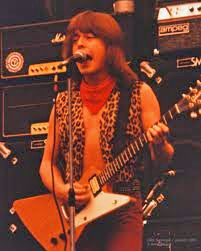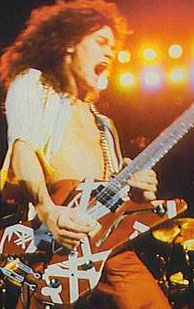More on the DiMarzio Super Distortion
(Part 2 of 2)
From Tuesday’s post you see that Al Di Meola and Ace Frehley were big-time DiMarzio Super Distortion (DSD) users. Who else was in that club? Here’s a partial list, in no particular order:
Tom Scholz (still uses)
Paul Stanley (used Dual Sound, a coil-tapped DSD)
Edward Van Halen (early, modified – see below)
Rick Derringer
Edgar Winter
Pete Townshend (later)
Mick Mars (early)
Iron Maiden (still use)
Aerosmith (experimented with everything)
Blackfoot
Brownsville Station
Paul Gilbert (early)
Boston, 1979, a little tough to tell because Scholz uses his Power Soak to get even more sustain, but still sounds woody.
KISS, 1975, listen to Ace’s tone starting about 2:40.
Blackfoot, 1982, listen to Rickey Medlocke’s tone (DSD) vs. Charlie Hargrett’s (stock pickups) – neither used pedals.
More: DiMarzio
More on the DSD, from the DiMarzio website:
“This pickup started a sound revolution. Replacement pickups simply didn’t exist before the invention of the Super Distortion in the early Seventies. The Super Distortion (and its original 3-conductor version, the Dual Sound) was the first pickup specifically designed to kick a tube amp into total overdrive, and is still the standard by which all other high-output pickups are measured.
“The Super Distortion has a perfect blend of power and tone: both single-notes and chords jump out of the amp and fill the room (or the track) with a wall of sound. [This is true – single notes do not thin out.] The balance of tones is classic – thick, boosted mids, big lows and fat highs. This is the sound you’ve heard for over three decades on platinum records, from players as varied as Ace Frehley, Al Di Meola and Paul Gilbert.
“The Super Distortion is primarily a bridge-position pickup, although it can be used in the neck position with a relatively low-gain amp. Specifically designed for solid-bodies: hollow and semi-hollow guitars can be hard to control with warm, high output pickups.”
More: Gilbert
Also from the DiMarzio website: “Paul Gilbert used to use two Super Distortions wired in parallel when he was in Racer X. Parallel wiring [4-conductor] is similar to splitting, but it’s still humbucking and a little more hollow-sounding.”
More: EVH
Early on, Ed was like every other classic rock guit-slinger: Trying to get more sustain out of what he had. He tried DSDs and the Mighty Mite clones, and ended up here, from the 1980 Guitar Player interview (more highlights of that interview here):
I don’t really go for DiMarzio pickups because they’re real distorted. I like a clean sound with sustain — I hate the fuzz box, real raspy sound. So I put a PAF magnet in a DiMarzio pickup and rewound it by hand….”
Note the word he chooses: sustain, not distortion.
More: DCR
Everyone talks about how a pickup’s DC Resistance is an indicator of output. Pickup manufacturers do their best to try to dissuade people of that notion, but in the absence of a cross-manufacturer scale or standard of some kind, it hasn’t worked.
The DCR of the DSD is 13.68K, which most people would say indicates high output. For comparison, a PAF is about in the 8K range. Still, here’s what Larry DiMarzio says about it, from a premierguitar.com interview:
“DC resistance by itself has nothing to do with output level, for several reasons. First, it doesn’t take wire gauge into account. The thinner the wire gauge, the higher the resistance. So fewer turns of thinner wire can produce the same resistance as more turns of heavier wire. Fewer turns would produce less output.
“Second, the type and size of magnet will have a major effect on output level. It’s true that a Super D is louder than an Air Zone, but it’s not really about ceramic versus alnico—we have some ceramic-powered humbuckers that are not as loud as some alnico-equipped models.
The only accurate way to directly compare output level (loudness) is to check the output spec, which is measured in millivolts and published for each pickup model on the DiMarzio website.”
More: Pots
From another PG article about pickups, not Larry speaking:
“With passive pickups, the general rule is 500k pots for humbucking pickups and 250k pots for singlecoils. This is not a hard and fast rule, however. Generally, the higher the impedance of the pot, the more highs are allowed through. If you have installed a humbucker and found it to be a bit too bright or brittle, changing from a 500k to a 250k pot might just do the trick.
Also, don’t forget 1-meg [1,000k] pots. In the sixties, Fender began to install 1-meg pots on Telecasters. Certain country artists were looking for bright, twangy Tele tones and this pot value did the trick. I have also seen seemingly dark humbuckers scream with harmonics while using this pot.
“It is important to remember that there are no rules here – use what you like. Pots are an inexpensive, simple way to experiment with your tone.” [But changing pots and resoldering is a pain in the a**! – although both DiMarzio and Seymour Duncan have solderless systems now.]
Category: Ace Frehley, Blackfoot, DiMarzio, Edward Van Halen, Paul Gilbert, Tom Scholz/Boston
















thank you, thank you, thank you. love this pickup. Phil Collen uses it in his Ibanez Destroyer, I think it figures heavy in early Slayer, and of course J Priest. I was telling my friend how BAAADAASSS Mick Mars sounds on The first album, TOO FAST FOR LOVE, then as I walked away, I realized I should put my money where my mouth is and try the SuperD if thats what he used. Once i got it at the right height I fell in complete lust with it. Although its smooth by todays standards, it growls with alot of chunky woody tone, a chewy bite, and wicked pinch harmonics. Nice one by u, woodytone!